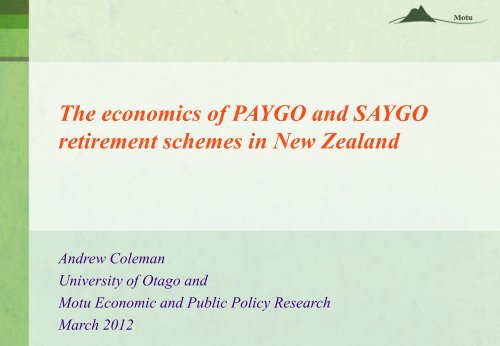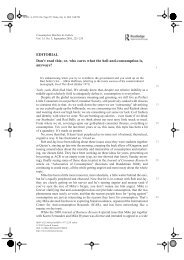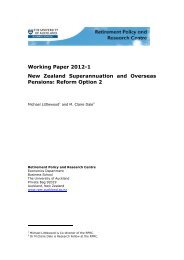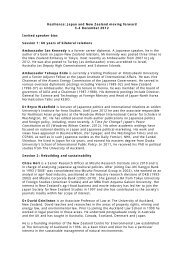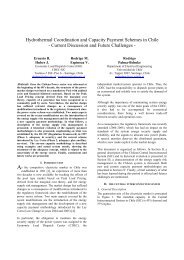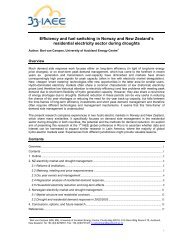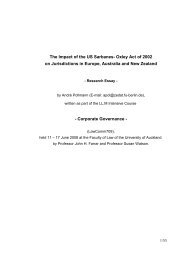The economics of PAYGO and SAYGO retirement schemes in NZ
The economics of PAYGO and SAYGO retirement schemes in NZ
The economics of PAYGO and SAYGO retirement schemes in NZ
Create successful ePaper yourself
Turn your PDF publications into a flip-book with our unique Google optimized e-Paper software.
<strong>The</strong> <strong>economics</strong> <strong>of</strong> <strong>PAYGO</strong> <strong>and</strong> <strong>SAYGO</strong><strong>retirement</strong> <strong>schemes</strong> <strong>in</strong> New Zeal<strong>and</strong>Andrew ColemanUniversity <strong>of</strong> Otago <strong>and</strong>Motu Economic <strong>and</strong> Public Policy ResearchMarch 2012
Peter Diamond(MIT, Nobel prize 2010)1. If r < g, it is efficient toimmediately adopt a <strong>PAYGO</strong>system as there is too much capital2. Empirically r>g, <strong>and</strong> <strong>in</strong> long run<strong>SAYGO</strong> is more efficient than<strong>PAYGO</strong> because compound<strong>in</strong>greturns mean you can have lowercontributions for same pension3. If you start with <strong>PAYGO</strong>, thetransition is difficult as onegeneration has to double pay.
More recent research4. <strong>The</strong> transition is not asdifficult as once thought5. Risk considerations meanthat a mixed <strong>PAYGO</strong>-<strong>SAYGO</strong> system is best.6. But how much <strong>SAYGO</strong>,<strong>and</strong> what form?
Mart<strong>in</strong> Feldste<strong>in</strong>(Harvard University, CEA under Reagan)•1984: <strong>The</strong> transition is toohard to manage
Mart<strong>in</strong> Feldste<strong>in</strong>2005 AEA Presidential address“I now know I was wrong”When returns are high, thetransition can be managedus<strong>in</strong>g private accounts.
Basic issues(1) <strong>PAYGO</strong> (2) <strong>SAYGO</strong>ProductivitygrowthPopulationgrowthAssetsaccumulatedProvides capitalreturns(3)Important issues(i)Divergent capitalpaths(ii) Label<strong>in</strong>g(iii)Intergenerationalcosts
Basic issues(1) <strong>PAYGO</strong>ProductivitygrowthPopulationgrowth
Basic issues(1) <strong>PAYGO</strong> (2) <strong>SAYGO</strong>AssetsaccumulatedProvidescapital returns
Basic issues(1) <strong>PAYGO</strong> (2) <strong>SAYGO</strong>(3)Important issues(i)Divergent capitalpaths(ii) Label<strong>in</strong>g(iii)Intergenerationalcosts
(i) Divergent capital pathsWhen a <strong>PAYGO</strong> scheme starts (US, 1938),– Retired people get more resources <strong>and</strong> <strong>in</strong>crease consumption– Work<strong>in</strong>g age people pay taxes, <strong>and</strong> because they arepromised a future pension they accumulate less capital butma<strong>in</strong>ta<strong>in</strong> consumption– Total consumption <strong>in</strong>creases– Capital accumulation reduces, reduc<strong>in</strong>g future size <strong>of</strong> theeconomy
Consumption<strong>SAYGO</strong><strong>SAYGO</strong>Capitaltimetime
(ii) Labell<strong>in</strong>g<strong>The</strong> same result occurs if– Government adopts a <strong>PAYGO</strong> system• old people get resources now,• work<strong>in</strong>g age pay taxes now, get pension later– Government borrows from work<strong>in</strong>g age people to give apension to the old, <strong>and</strong> repays them with <strong>in</strong>terest whenretired• Capital accumulation falls as government crowds out private sectorasset accumulation– Different labels but same result…..the dist<strong>in</strong>ction with a<strong>SAYGO</strong> system is that no capital is accumulated.
(iii) Intergenerational costs.When r>g, a <strong>PAYGO</strong> scheme imposes costs on allsubsequent generations as their taxes could haveearned more <strong>in</strong>vested <strong>in</strong> capital.– <strong>The</strong> consumption ga<strong>in</strong> to the <strong>in</strong>itial generation is <strong>of</strong>fset byconsumption losses to all subsequent generations.<strong>The</strong> sum <strong>of</strong> these costs, discounted at the return to capitalequals the <strong>in</strong>itial transferA near mean<strong>in</strong>gless result, as it is true whether r = 5% orr = 15%.
(iii) Intergenerational costs.<strong>The</strong> ma<strong>in</strong> issue is that adopt<strong>in</strong>g a <strong>PAYGO</strong> imposes costson some generations to transfer to others.<strong>The</strong> costs on subsequent generations is higher the higheris the gap between r <strong>and</strong> gWhen the population growth rate slows, later generationshave higher costs than earlier ones.Increas<strong>in</strong>g the <strong>SAYGO</strong> component imposes costs on thetransition generation to lower subsequent costs.
<strong>The</strong> Ma<strong>in</strong> Argument<strong>The</strong> cost <strong>of</strong> the current scheme will rise, impos<strong>in</strong>glarger costs on future generationsReduc<strong>in</strong>g the size <strong>of</strong> the <strong>PAYGO</strong> scheme <strong>and</strong><strong>in</strong>creas<strong>in</strong>g the <strong>SAYGO</strong> component will partially shiftthese costs from the future to the present<strong>The</strong> transition can be managed to <strong>in</strong>crease capitalaccumulationSeveral different <strong>SAYGO</strong> options can be considered
So….what are the numbers like for <strong>NZ</strong>?
tax ratesTransition PathsProjected pension expenditure due to demographic change12%8%4%<strong>PAYGO</strong> regime0%2011 2021 2031 2041 2051 2061
<strong>PAYGO</strong>Public flatrateXPublicearn<strong>in</strong>gsrelatedM<strong>and</strong>atoryprivateVoluntaryprivate<strong>SAYGO</strong>XX XX
Relative efficiencyLong term relative efficiency <strong>of</strong><strong>SAYGO</strong> <strong>and</strong> <strong>PAYGO</strong>• Mimic economy <strong>and</strong> population <strong>in</strong> 2050• Real return = 4%• Productivity growth = 1.5%, wage = $90000• 45 year work<strong>in</strong>g life, 19 year pension
Relative efficiencyResults r = 4%T N R g W g R S t Totalassets<strong>SAYGO</strong>tax rate<strong>PAYGO</strong>tax rate<strong>SAYGO</strong>/<strong>PAYGO</strong>1 45 19 4.0% 1.5% 1.5% $419,310 $557b 3.2% 7.2% 44%2 45 19 4.0% 1.5% 0.0% $366,437 $475b 2.8% 6.2% 45%3 47 17 4.0% 1.5% 1.5% $383,732 $457b 2.9% 6.2% 47%4 47 17 4.0% 1.5% 0.0% $339,422 $396b 2.4% 5.4% 44%
Relative efficiency• <strong>SAYGO</strong> requires approximately half thecontributions as <strong>PAYGO</strong>• A very large quantity <strong>of</strong> assets (nearly 2xGDP)is required to make full transition
Transition PathsF<strong>in</strong>d<strong>in</strong>g Transition Paths• F<strong>in</strong>d paths that end at long rate <strong>SAYGO</strong> rateafter N years.• Over the transition period, the fund mustaccumulate the required level <strong>of</strong> assets.• Inf<strong>in</strong>ite variety <strong>of</strong> paths: look for ones withsmooth transition.
Transition Pathstax rates<strong>SAYGO</strong> transitions - 1Transition tax rates50 year transition to full <strong>SAYGO</strong> regime12%<strong>SAYGO</strong> regimes<strong>in</strong>crease 2012 taxes by 2.2% GDP8%4%<strong>PAYGO</strong> tax path0%0 5 10 15 20 25 30 35 40 45years<strong>SAYGO</strong> regime ends at3.2 % GDP
Transition Pathstax rates<strong>SAYGO</strong> transitions - 3Transition tax rates60 year transition to 0.72 <strong>SAYGO</strong> regime12%<strong>SAYGO</strong> regime<strong>in</strong>crease 2012 taxes by 2.8%GDP8%4%<strong>PAYGO</strong> regime0%0 5 10 15 20 25 30 35 40 45 50 55years<strong>SAYGO</strong> regime ends at4.3 % GDP
Transition Pathstax rates<strong>SAYGO</strong> transitions - 4Transition tax rates60 year transition to 0.50 <strong>SAYGO</strong> regime12%<strong>SAYGO</strong> regime<strong>in</strong>crease 2012 taxes by 2.2% GDP8%4%<strong>PAYGO</strong> regime0%0 5 10 15 20 25 30 35 40 45 50 55years<strong>SAYGO</strong> regime ends at5.2 % GDP
A partial transition can be obta<strong>in</strong>ed keep<strong>in</strong>g taxesbelow long term <strong>PAYGO</strong> rate, <strong>and</strong> reductionspossible sooner.
Double PayDouble Pay• To make the transition, some cohorts will needto pay more.• Is this fair?• We can calculate how much each cohort haspaid, <strong>and</strong> how much each cohort can expect toreceive
Double Pay• I look at a cohort turn<strong>in</strong>g 60 <strong>in</strong> 1981 or 2011 or2041 etc• I calculate the number <strong>of</strong> person years thecohort lives from 20 – pension age, <strong>and</strong> afterthe number after pension age• <strong>The</strong> ratio provides an estimate <strong>of</strong> the number <strong>of</strong>years someone is supported for each year theyare “work<strong>in</strong>g age”
Double PayDependency ratioI then calculate <strong>in</strong> each year the ratio <strong>of</strong> the number <strong>of</strong>people receiv<strong>in</strong>g a benefit to the number <strong>of</strong> peopleaged 20 – 65This is the number <strong>of</strong> people you provide support to <strong>in</strong> aparticular yearWhen averaged over 45 years, this is the average number<strong>of</strong> people you support each year you are work<strong>in</strong>g age
Double PayTable 3 Cohort eligibility ratios <strong>and</strong> average dependency ratios by birth cohortYearturn<strong>in</strong>g 60Years
Double PayDependency ratioI then calculate <strong>in</strong> each year the ratio <strong>of</strong> the number <strong>of</strong>people receiv<strong>in</strong>g a benefit to the number <strong>of</strong> peopleaged 20 – 65This is the number <strong>of</strong> people you provide support to <strong>in</strong> aparticular yearWhen averaged over 45 years, this is the average number<strong>of</strong> people you support each year you are work<strong>in</strong>g age
Double PayTable 3 Cohort eligibility ratios <strong>and</strong> average dependency ratios by birth cohortYearturn<strong>in</strong>g 60Years
Double PayAverage Dependency ratio <strong>and</strong> Cohort Eligibility ratio,cohorts turn<strong>in</strong>g 60 1975 - 204560%50%40%Cohort eligibilityFraction <strong>of</strong> life spent overage <strong>of</strong> eligibility for cohortturn<strong>in</strong>g 60 <strong>in</strong> year30%20%10%Average Dependency ratioaverage dependency ratio<strong>in</strong> preceed<strong>in</strong>g 40 years1976 1981 1986 1991 1996 2001 2006 2011 2016 2021 2026 2031 2036 2041 2046
Double PayFor all cohorts turn<strong>in</strong>g 60 between 1980 – 2031, peopleget a pension for at least 80% more person years thanthey provided a pension to others.<strong>The</strong> cohort turn<strong>in</strong>g 60 <strong>in</strong> 2046, still gets a pension for atleast 50% more person years than they provided apension to others.
Double PayThis is somewhat crude.• We need to take <strong>in</strong>to account the size <strong>of</strong> thepension• Taxes are paid for all <strong>of</strong> your life, not just whenyou are 20 - 65
Double PayAverage pension tax contributions <strong>and</strong> receipts by cohort25.0%Receipts adjusted for size <strong>of</strong> cohort20.0%15.0%10.0%5.0%Payments adjusted for post-<strong>retirement</strong> tax contributions0.0%1976 1981 1986 1991 1996 2001 2006 2011 2016 2021 2026 2031 2036 2041 2046Cohort turn<strong>in</strong>g 60 <strong>in</strong> particular year
Double PayBottom l<strong>in</strong>eAlmost all cohorts can expect to get twice asmuch <strong>in</strong> pension benefits as they paid <strong>in</strong> taxesto provide benefits to others.
Will sav<strong>in</strong>gs rise dur<strong>in</strong>g thetransition?Suppose the government <strong>in</strong>creases taxes now to prefund<strong>NZ</strong> Superannuation/ operate private accounts system.Will this raise capital accumulation?It won’t if the private sector reduces its other sav<strong>in</strong>gIt probably will if the contribution <strong>in</strong>crease comes byrestra<strong>in</strong><strong>in</strong>g consumption <strong>in</strong>creases as <strong>in</strong>come risesThis worked <strong>in</strong> Australia
<strong>SAYGO</strong> options<strong>PAYGO</strong>Public flatrateXPublicearn<strong>in</strong>gsrelatedM<strong>and</strong>atoryprivateVoluntaryprivate<strong>SAYGO</strong>X X X X
Private accounts are only one optionPrivate accounts l<strong>in</strong>k benefits to contributions <strong>and</strong> reducethe dis<strong>in</strong>centives <strong>of</strong> high marg<strong>in</strong>al taxes.<strong>The</strong>y can be arranged so that most people are better <strong>of</strong>f(Feldste<strong>in</strong> &Samwick, Feldste<strong>in</strong> & Liebman)FSC proposal provides a plan to run down sav<strong>in</strong>gs <strong>in</strong><strong>retirement</strong>
If we cut <strong>PAYGO</strong>, we use voluntary<strong>SAYGO</strong>Suppose the government raised the age <strong>of</strong> eligibility.This reduces the size <strong>of</strong> the <strong>PAYGO</strong> componentIf households save more, this is an unstructured<strong>SAYGO</strong> response.This is perfectly coherent…..<strong>and</strong> there are costs to tellpeople when <strong>and</strong> how to save.
If we cut <strong>PAYGO</strong>, we use voluntary<strong>SAYGO</strong>This is the option favoured by people to the right <strong>of</strong>Feldste<strong>in</strong> <strong>in</strong> many countries.But most countries prefer structured sav<strong>in</strong>g arrangements<strong>NZ</strong> already has smallest structured <strong>retirement</strong> sav<strong>in</strong>garrangements <strong>in</strong> OECD….do we want to shr<strong>in</strong>k itfurther?
AustraliaAustralia• S<strong>in</strong>ce 1992, Australia has adopted a mixed<strong>SAYGO</strong>-<strong>PAYGO</strong> system• Means tested Government pension ($A19500currently) at age 65 (ris<strong>in</strong>g to 67)• M<strong>and</strong>atory <strong>in</strong>dividual account with 9%contributions (ris<strong>in</strong>g to 12%)
AustraliaAustralia – <strong>NZ</strong><strong>retirement</strong> <strong>in</strong>come for median personAustraliaNew Zeal<strong>and</strong>2035 $A41000 $<strong>NZ</strong>225002055 $A60800 $<strong>NZ</strong>33100
Australia• Australians currently pay more <strong>in</strong> <strong>and</strong> get muchmore out.• However, the amount they pay <strong>in</strong> will rise bylittle between now <strong>and</strong> 2050• In <strong>NZ</strong>, the amount we pay <strong>in</strong> will nearly doublebetween now <strong>and</strong> 2050
Australia• By 2050, Australians will pay <strong>in</strong> 9.7% <strong>of</strong> GDPversus 7.4% <strong>of</strong> GDP <strong>in</strong> <strong>NZ</strong>• <strong>The</strong>y will get a pension out that is 52% <strong>of</strong> percapita GDP versus 34% <strong>of</strong> per capita GDP
Sav<strong>in</strong>g HabitsSpend<strong>in</strong>g Halfbits
Conclusions1. <strong>SAYGO</strong> is more efficient2. Transition to a partial scheme is feasible3. Mak<strong>in</strong>g current cohorts pay more is fair4. If we don’t change, we will have much less efficientscheme than Australia
Wait<strong>in</strong>g for Highl<strong>and</strong>ers to bridge the gap


